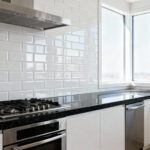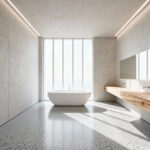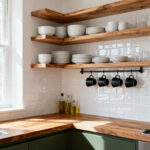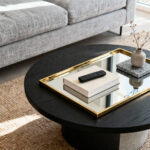Dreaming of a kitchen that’s more than just a place to cook? Today’s modern kitchen interior blends sleek design with smart functionality to create spaces that are both beautiful and practical. I’ve spent years helping clients transform ordinary kitchens into extraordinary living spaces, and I’m excited to share what truly makes a difference.
Forget outdated designs and cluttered countertops. Modern kitchens embrace clean lines, innovative materials, and thoughtful organization. Whether you’re planning a complete renovation or looking for inspiration to refresh your current space, these 22 essential elements will help you create a kitchen that’s as stunning as it is functional.
1. Sleek Quartz Countertops: The Secret to Effortless Modern Kitchen Elegance
Quartz countertops have become the cornerstone of sophisticated modern kitchen interiors, and for good reason. They offer that perfect balance of refined aesthetics and practical durability that today’s homeowners crave. Unlike natural stone, quartz provides consistent patterning and color, creating a clean, contemporary look that complements minimalist design principles beautifully.

When comparing quartz to alternatives like granite or marble, the advantages become clear. Quartz is non-porous, making it remarkably resistant to stains and bacteria without requiring regular sealing. While marble exudes luxury, it’s considerably more vulnerable to etching from everyday kitchen acids. For clients seeking both beauty and functionality, I often recommend a waterfall edge on kitchen islands—it creates a stunning focal point that emphasizes the sleek qualities of quartz.
Here’s where it gets interesting—quartz isn’t actually a solid stone slab. It’s engineered from approximately 90-95% ground natural quartz combined with resins and pigments, giving designers unprecedented control over appearance while maintaining exceptional durability.
2. Embrace Handleless Cabinets: The Epitome of Modern Minimalist Kitchen Design
Handleless cabinets instantly elevate any modern kitchen interior with their sleek, uninterrupted lines. They embody the essence of minimalism—visual simplicity that creates a sense of space and calm. Beyond aesthetics, they offer practical benefits: no protruding hardware means fewer bumps and snags, especially valuable in homes with children or in kitchens with tight walkways.
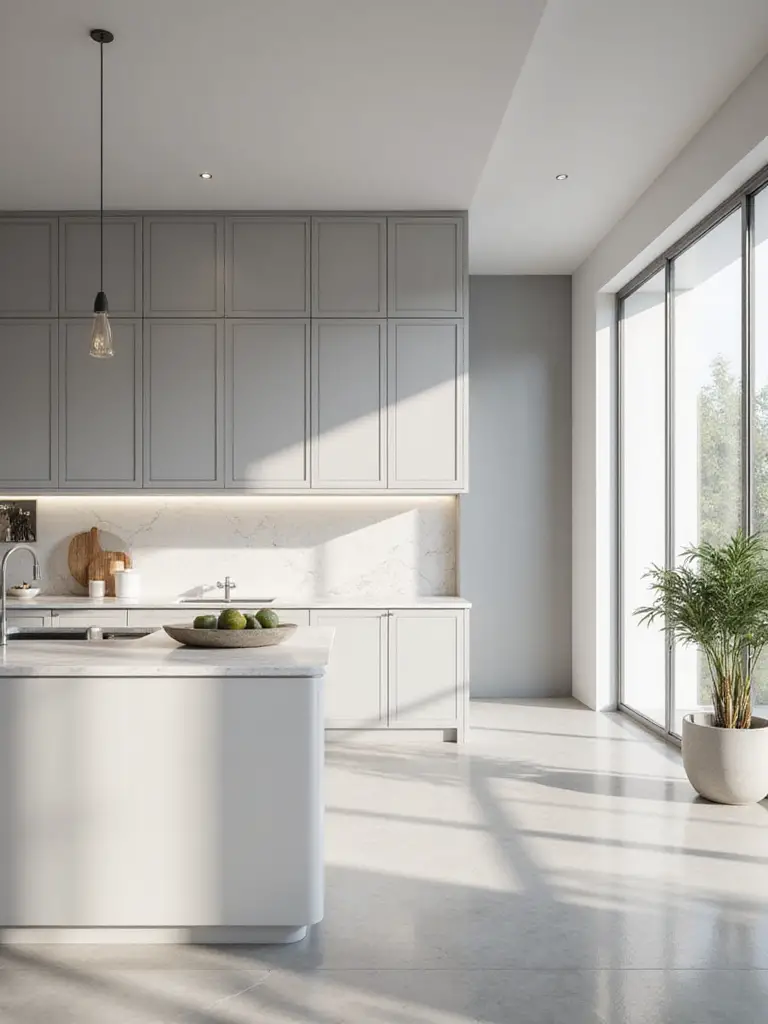
The technology behind these streamlined cabinets has evolved dramatically. You can choose from push-to-open mechanisms that activate with a gentle press, integrated J-pull or C-channel designs that provide subtle finger grips, or even electric servo drives that open with just a light touch. For my clients seeking balance, I often recommend combining handleless upper cabinets with integrated-handle lower cabinets—you get the sleek look above with the reliable functionality below.
The stumbling block for many homeowners is understanding the space requirements. When planning handleless cabinets, ensure adequate clearance around appliances for easy access, as the lack of handles sometimes makes it challenging to open adjacent cabinets simultaneously.
3. Infuse Warmth with Wood Accents: Bringing Nature into Your Modern Kitchen
In modern kitchen interiors that embrace clean lines and minimalist aesthetics, wood elements provide essential warmth and character. Without these natural touches, contemporary kitchens risk feeling cold or sterile. Wood brings an organic quality that softens the hard edges and reflective surfaces common in modern design, creating a more inviting atmosphere.
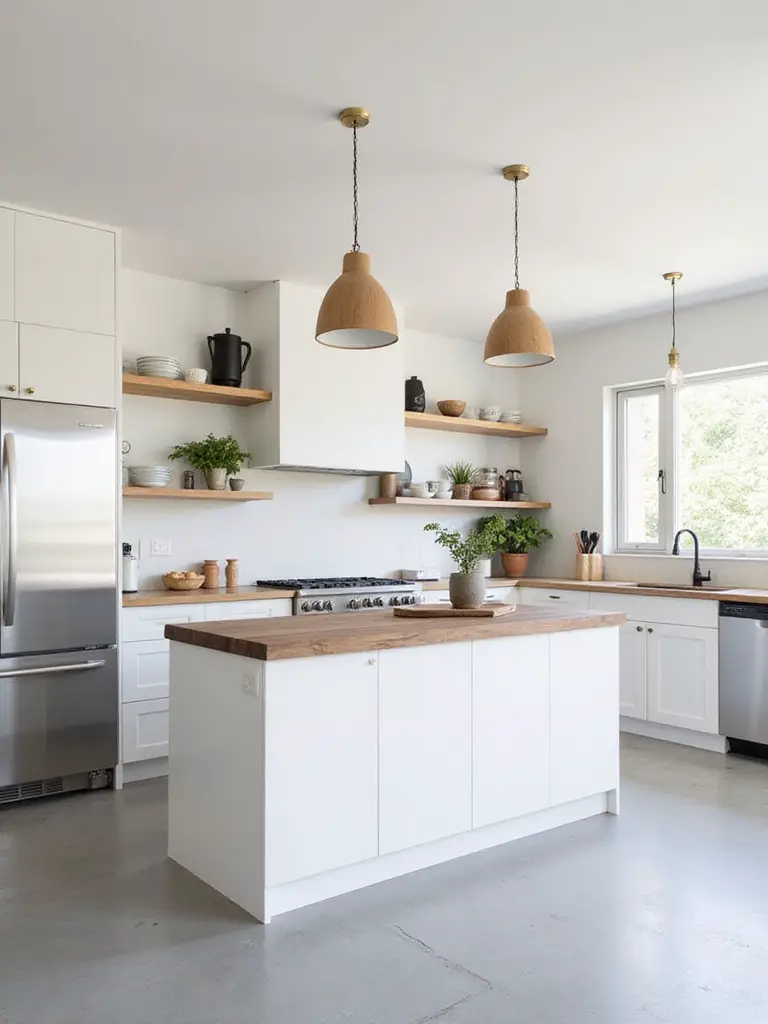
The beauty of incorporating wood lies in its versatility. You might consider a natural wood island contrasting against painted perimeter cabinets, open shelving displaying warm-toned ceramics, or a custom-built wooden range hood as a stunning focal point. Even smaller accents—cutting boards artfully arranged on countertops or wooden pendant lights—can significantly enhance the textural richness of your space.
“Wood is the great mediator in modern kitchen design—it bridges sleek contemporary elements with timeless comfort, ensuring your space feels both current and welcoming.”
4. Make a Statement with Bold Backsplashes: Adding Personality and Pop to Your Kitchen
A bold backsplash transforms a modern kitchen interior from simply functional to memorably striking. In spaces often dominated by neutral cabinetry and countertops, the backsplash offers a perfect canvas for personal expression. It breaks potential monotony and creates a focal point that instantly draws the eye and reflects your unique style.
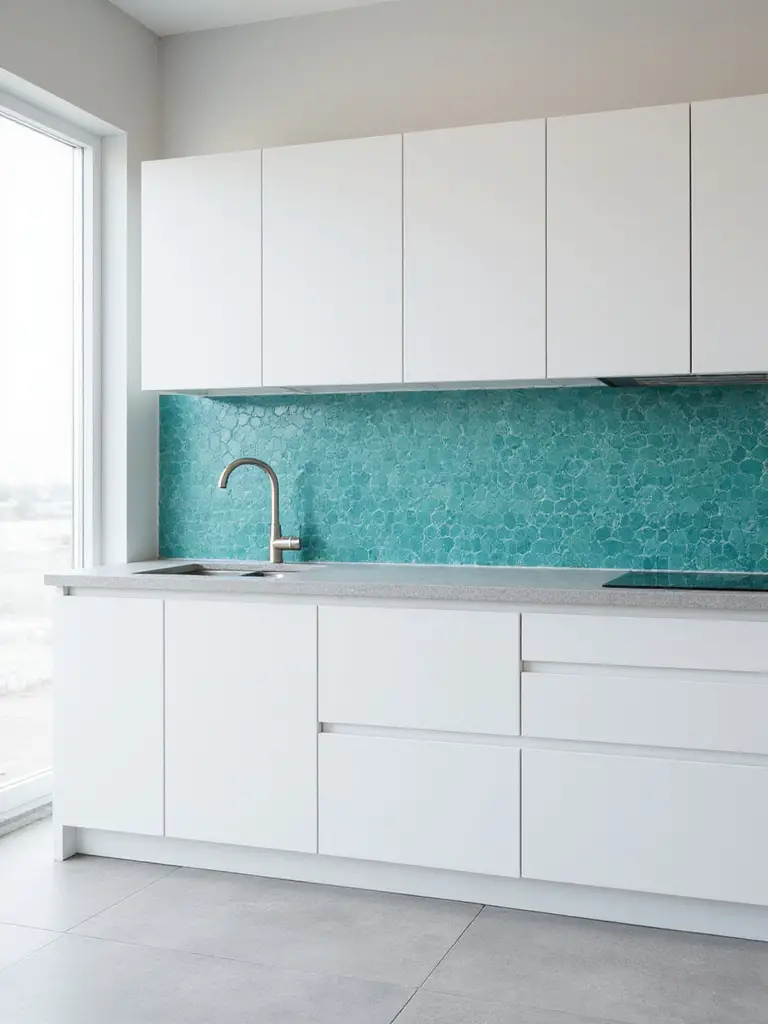
The materials available for creating impactful backsplashes are wonderfully diverse. Consider:
- Ceramic or porcelain tile in vibrant colors or unusual shapes
- Glass tiles with iridescent finishes that shift color under different lighting
- Metal sheets in stainless steel, copper, or brass for industrial elegance
- Natural stone with dramatic veining for organic luxury
- Wallpaper protected behind glass for easily changeable patterns
What complicates this choice is finding the right balance—you want impact without overwhelming the space. Before committing, gather samples and place them alongside your cabinetry and countertops to see how they interact in your actual lighting conditions.
5. Durable and Chic Concrete Flooring: The Foundation of a Modern Kitchen
Concrete flooring has emerged as a standout choice for modern kitchen interiors, perfectly embodying contemporary design’s appreciation for materials in their authentic form. Its appeal extends beyond aesthetics—concrete delivers exceptional durability, standing up to kitchen traffic, dropped utensils, and spills with remarkable resilience. For busy households, this combination of style and substance is particularly compelling.
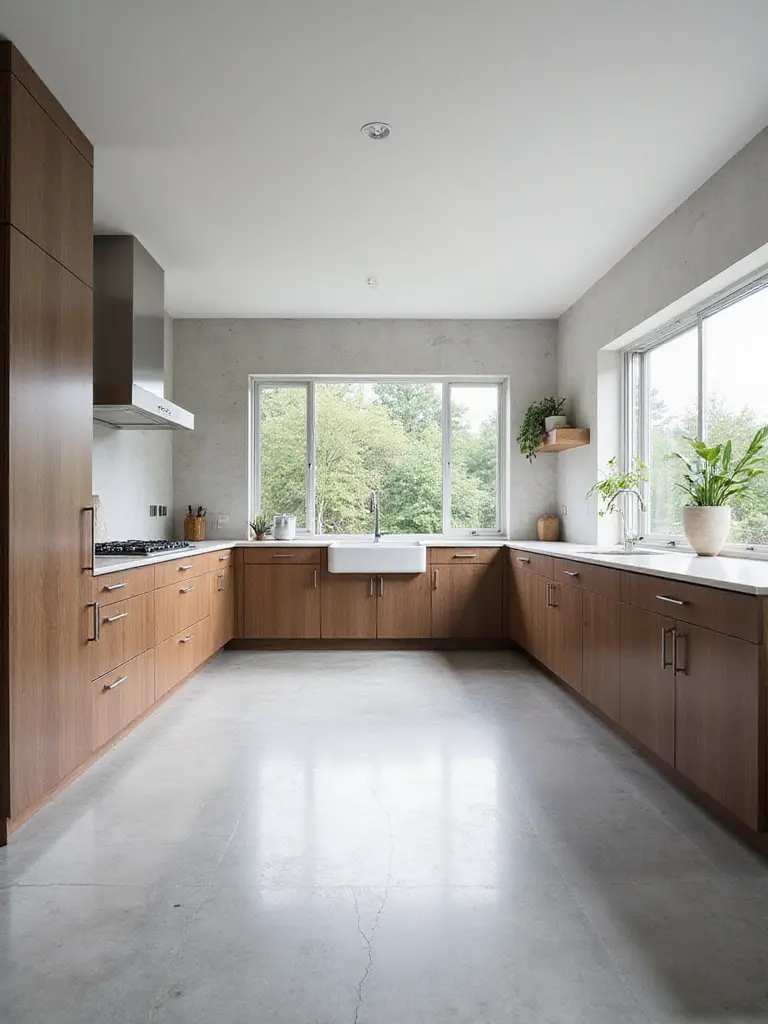
The transformative potential of concrete through various finishes allows for personalized expression. Polished concrete creates a sophisticated, light-reflecting surface that enhances brightness. Stained concrete offers color possibilities ranging from subtle earth tones to vibrant hues. For those concerned about concrete’s naturally cool feel, integrating radiant floor heating beneath provides luxurious comfort while maintaining the sleek look.
My discovery began when I installed concrete flooring in my own kitchen renovation—what surprised me most wasn’t just its beauty, but how it developed character over time, telling the story of our family gatherings and celebrations through subtle patina.
6. Timeless Monochromatic Color Schemes: Achieving Sophistication in Your Modern Kitchen
A monochromatic color scheme brings an enduring elegance to modern kitchen interiors through its inherent harmony and visual cohesion. Built upon variations of a single hue, this approach creates a sense of sophistication that transcends fleeting trends. The beauty lies in its simplicity—allowing architectural details and quality materials to become the stars rather than competing with a complex color palette.
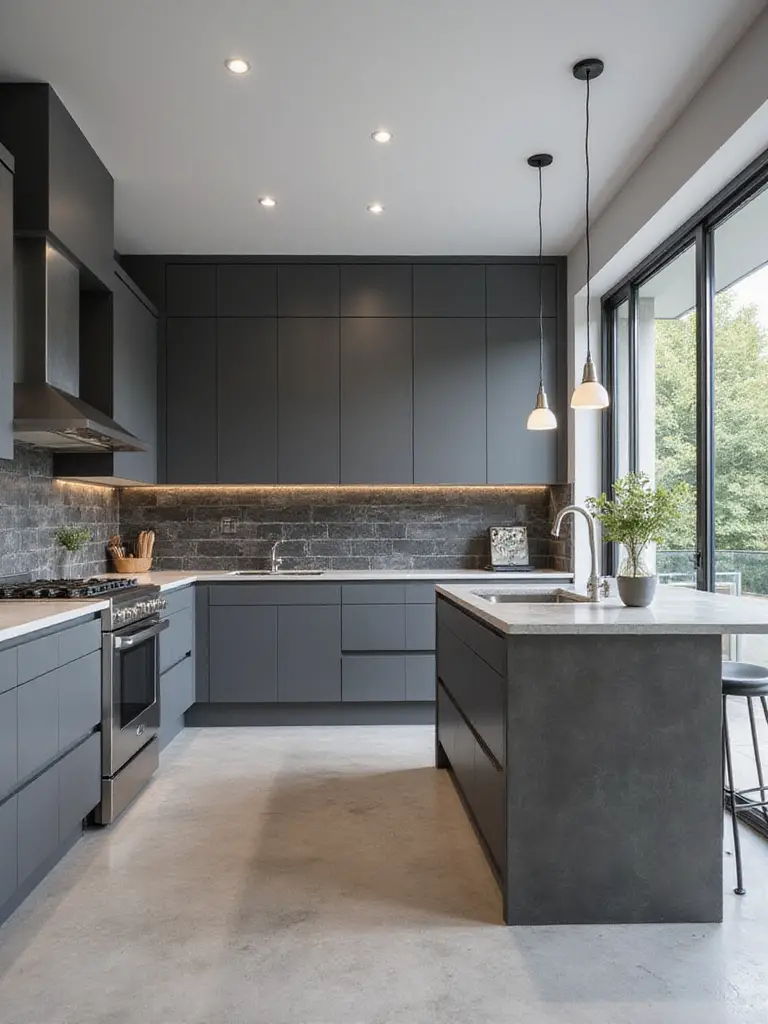
The key to preventing monochromatic kitchens from feeling sterile lies in thoughtful layering of textures and tones. Try pairing:
- Matte cabinets with glossy countertops
- Rough-hewn wood accents against sleek tile
- Various shades within your chosen color family (like light grey walls with charcoal cabinets)
- Metallic accents in gold, silver, or copper to add dimension and subtle glamour
The heart of the matter is creating depth through contrast while maintaining color harmony. Strategic lighting becomes essential here—combine ambient, task, and accent lighting to highlight different zones and create visual interest throughout the space.
7. Inject Energy with Bold Color Pops: Unexpected Hues for a Modern Kitchen
Bold color pops act as the pulse of a modern kitchen interior, injecting energy and personality into what might otherwise be a sterile environment. These strategic bursts of color create visual anchors, drawing the eye and breaking up the potential monotony of neutral palettes. They transform functional spaces into expressions of individuality.
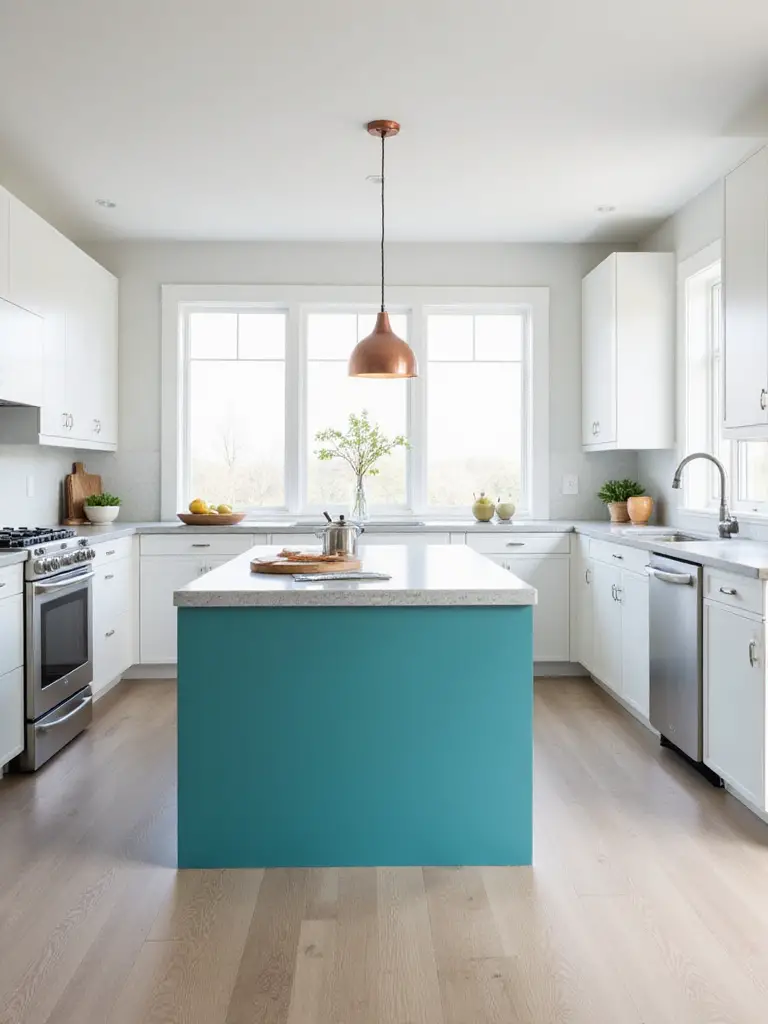
For truly memorable impact, venture beyond predictable kitchen colors. Consider:
- Emerald green lower cabinets paired with neutral uppers
- A mustard yellow island against white perimeter cabinetry
- Deep teal open shelving displaying white dishware
- Dusty rose pendant lights above a breakfast bar
The game-changer happened as I worked with a client who was initially hesitant about color. We introduced emerald green lower cabinets while keeping everything else neutral—the kitchen instantly transformed from forgettable to magazine-worthy, all while remaining sophisticated and timeless.
8. Embrace Minimalism: Discover the Beauty of Less in Modern Kitchen Design
Minimalism in modern kitchen interiors goes beyond aesthetic choice—it’s a philosophy centered on intentionality and purpose. Every element serves a function; every line contributes to the whole. This approach creates spaces that feel ordered and calm, where visual noise is eliminated and what remains is carefully considered and essential.
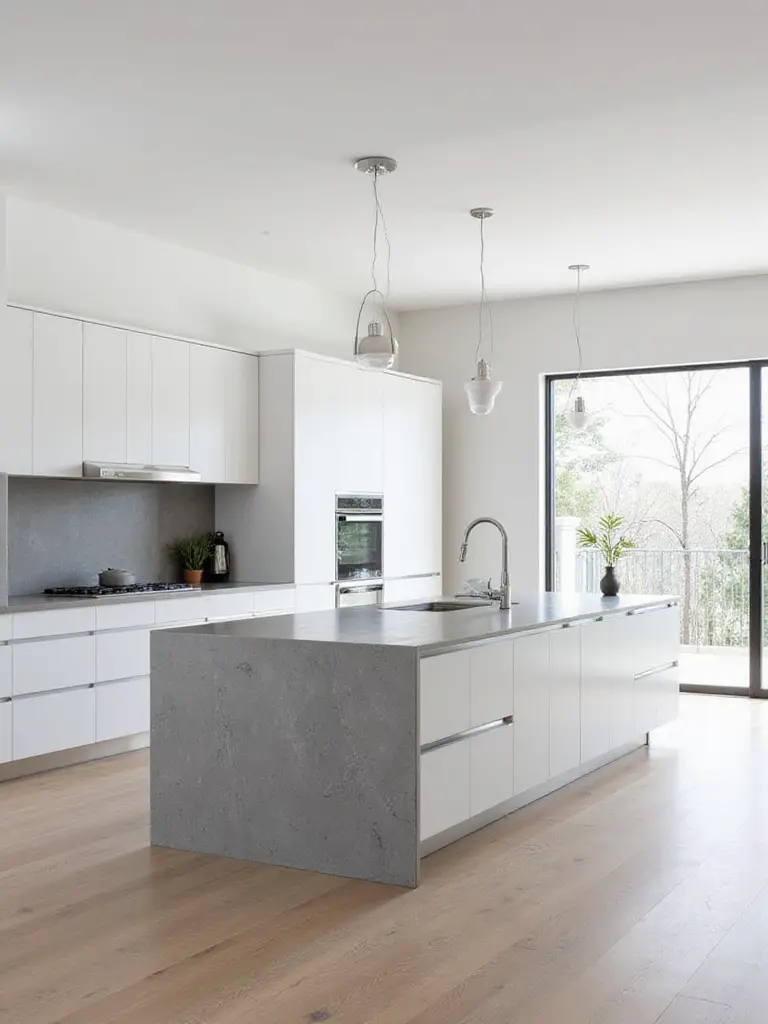
The practical benefits of minimalist kitchens extend to the cooking experience itself. With reduced clutter and distractions, meal preparation becomes more focused and enjoyable. Essential tools and ingredients are easily accessible, and the streamlined environment promotes efficiency. For many of my clients, this transformation from chaotic to composed kitchen spaces has actually rekindled their love of cooking.
“The most beautiful kitchens aren’t those with the most elements, but those where everything visible has earned its place.”
9. Industrial Chic Touches: Exposed Brick and Metal for an Edgy Modern Kitchen
Industrial chic elements bring character and depth to modern kitchen interiors through compelling contrasts. Exposed brick introduces texture and warmth against the cool precision of metal, creating visual tension that prevents kitchens from feeling too perfect or sterile. This juxtaposition of raw and refined creates spaces with soul and story.
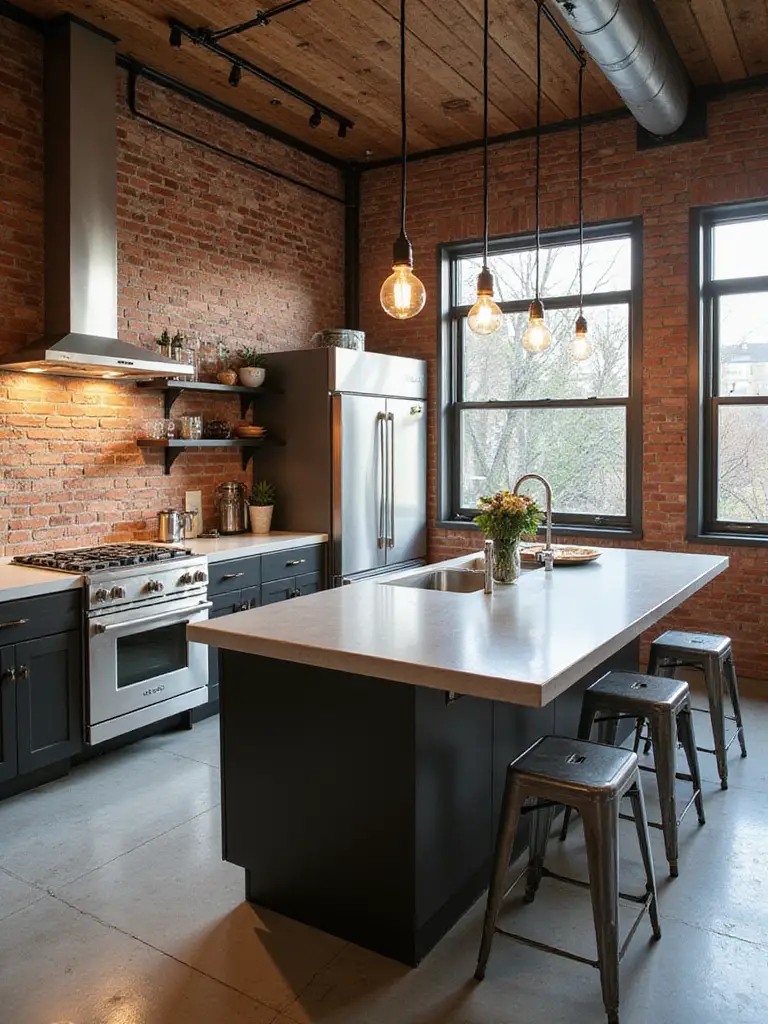
Different metals contribute unique qualities to the industrial aesthetic. Stainless steel offers clean, hygienic surfaces ideal for countertops and backsplashes. Brass and copper bring warmth and patina, softening industrial edges when used for lighting fixtures or hardware. For a truly distinctive look, consider reclaimed wood shelving with metal brackets against an exposed brick wall—this combination honors the industrial heritage while adding functional storage.
The ripple effects are enormous when you introduce these elements thoughtfully. Industrial touches connect your kitchen to architectural history, creating spaces that feel authentic rather than manufactured, with a timeless quality that transcends passing trends.
10. Modern Farmhouse Fusion: Blending Rustic Charm with Modern Kitchen Design
Modern farmhouse kitchens represent the perfect marriage between contemporary function and nostalgic warmth in today’s modern kitchen interiors. This style blends clean lines and minimalist sensibilities with character-rich elements that evoke comfort and tradition. The result is a light, bright space grounded by touches of history and natural materials.
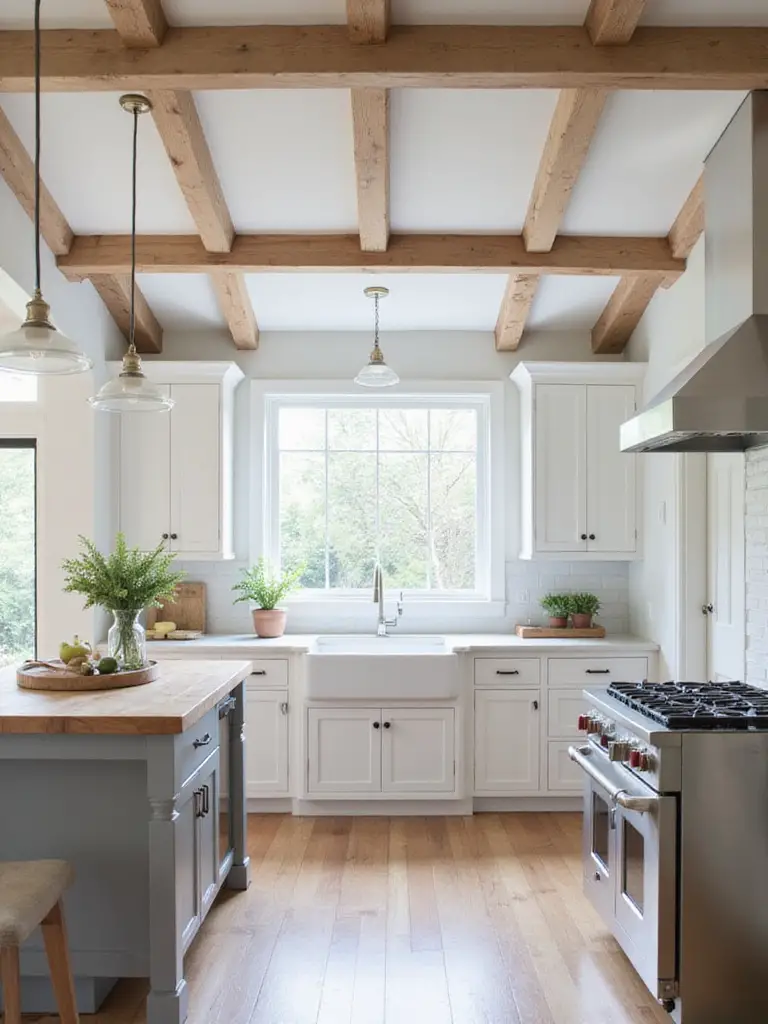
The secret to successful modern farmhouse design lies in selective incorporation of rustic elements. Rather than overwhelming the space with country details, choose a few standout features—perhaps a butcher block island countertop, shaker-style cabinetry, or an apron-front sink. These touches should be balanced with sleek appliances, contemporary lighting, and clean-lined cabinetry to maintain a fresh, current feel.
Picture it this way: modern farmhouse isn’t about recreating your grandmother’s kitchen—it’s about honoring those comfortable, welcoming qualities while embracing today’s lifestyle needs and aesthetic preferences.
11. The Essential Kitchen Island: Your Modern Kitchen’s Hub for Activity and Style
The kitchen island has evolved into the true heart of modern kitchen interiors—a multifunctional hub that defines both the space’s functionality and social dynamics. Beyond providing additional counter space, today’s islands integrate seating, storage, appliances, and even secondary sinks, creating a command center for cooking and gathering.
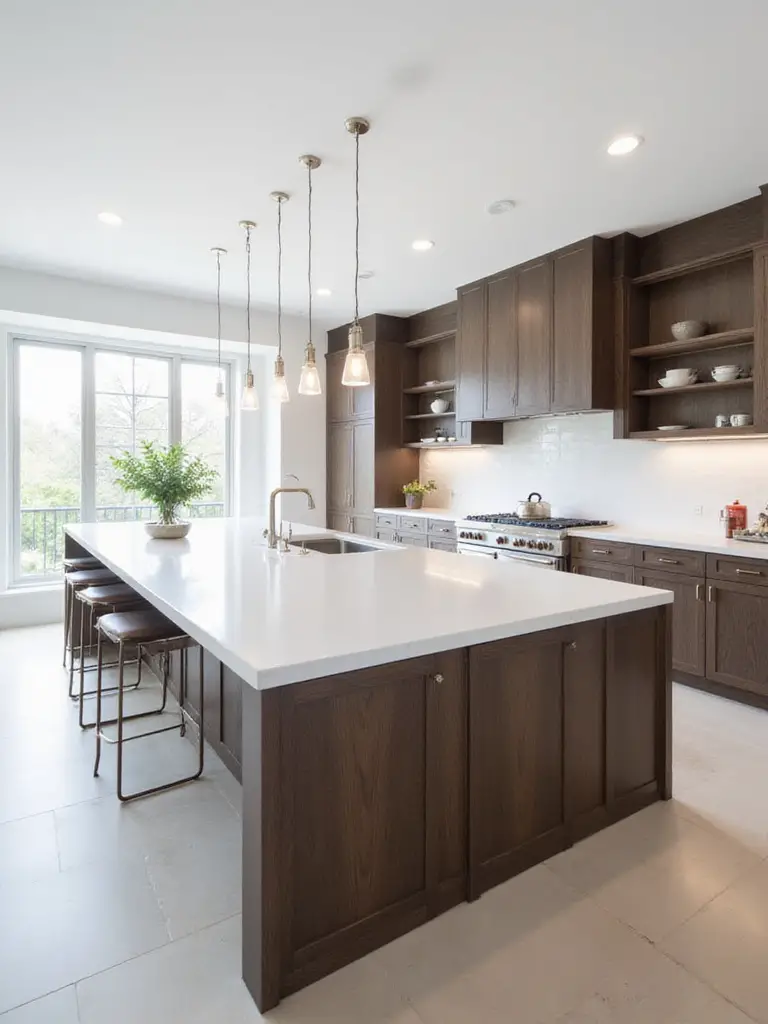
When designing your island, consider both proportion and purpose. A fundamental guideline is ensuring at least 42 inches of clearance around all sides for comfortable movement. The island’s primary function should dictate its features—prep-focused islands need ample surface area, while entertaining islands benefit from seating and perhaps a wine refrigerator. For a truly distinctive modern look, consider a waterfall countertop that cascades down the sides, creating a sculptural element that elevates the entire kitchen.
Let me paint you a picture: the island isn’t just another feature—it’s where homework happens while dinner cooks, where friends gather with wine glasses while you put finishing touches on a meal, and where morning coffee turns into afternoon project planning. It’s the social anchor of your home.
12. Open-Concept Kitchens: Creating a Seamless Flow and Social Hub in Your Modern Home
Open-concept kitchens have redefined modern kitchen interiors by dissolving traditional boundaries between cooking, dining, and living spaces. This design approach floods the entire area with natural light, creating brighter, more expansive-feeling homes. For entertainers and families alike, the connectivity fosters a more inclusive environment—cooks remain part of conversations while preparing meals, and parents can supervise children while handling kitchen tasks.
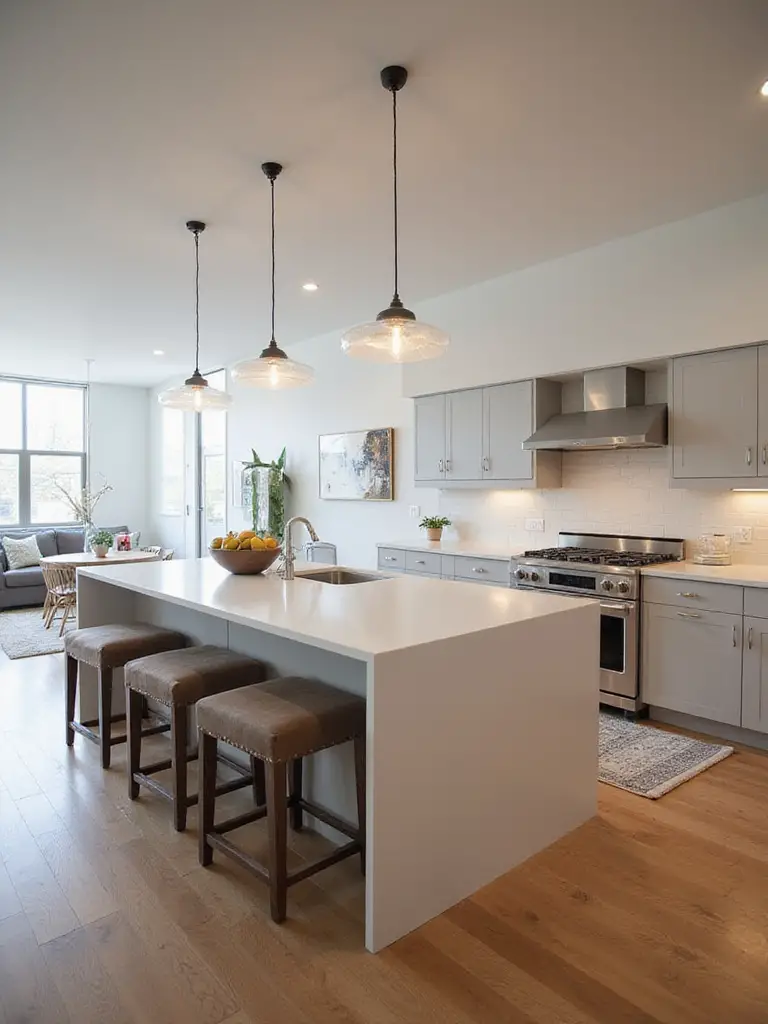
Successful open-concept designs require thoughtful planning to maintain both functionality and visual harmony. Clearly defined zones for cooking, dining, and relaxing—created through furniture placement, area rugs, and strategic lighting—help organize the space without walls. Ample storage becomes even more crucial, as everything visible contributes to the overall impression of your living area. A powerful range hood is non-negotiable to prevent cooking odors from permeating adjacent spaces.
The breakthrough came when homeowners realized open kitchens weren’t just about removing walls—they’re about reimagining how we live, entertain, and connect with others in our homes.
13. Clever Pantry Designs: Maximizing Storage and Organization in Your Modern Kitchen
A well-designed pantry transforms modern kitchen interiors by combining exceptional functionality with aesthetic order. Beyond simple storage, today’s pantries are sophisticated organizational systems that free up valuable cabinet and counter space, creating more streamlined main kitchens. The accessibility and visibility of a thoughtfully arranged pantry also reduces food waste and simplifies meal planning.
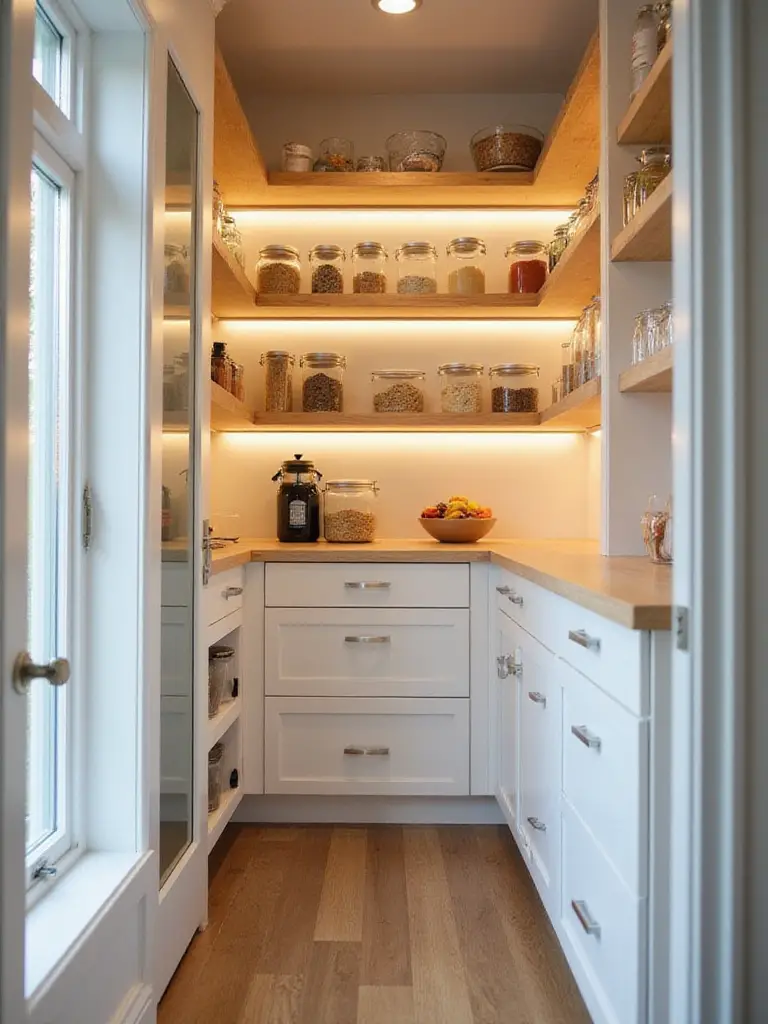
Modern pantry designs offer solutions for kitchens of every size:
- Walk-in pantries provide generous storage with adjustable shelving and specialized organizers
- Pull-out pantries maximize vertical space in smaller kitchens, revealing multiple shelves in a compact footprint
- Built-in pantries integrate seamlessly with kitchen cabinetry, maintaining a clean, minimalist look
- Butler’s pantries offer secondary kitchen spaces for storage, prep, and serving
The tricky part is customizing your pantry to your specific needs. Consider incorporating pull-out shelves or drawers for easy access to items at the back, and use clear containers and labels to maintain organization. The most successful pantries balance accessibility with capacity, ensuring frequently used items remain within easy reach.
14. Smart Storage Solutions: Banish Clutter and Embrace Order in Your Modern Kitchen
Smart storage is the unsung hero of successful modern kitchen interiors, working behind the scenes to maintain the clean, uncluttered aesthetic that defines contemporary design. The best storage solutions go beyond basic functionality to optimize accessibility, maximize space utilization, and support the minimalist visual language of modern kitchens.
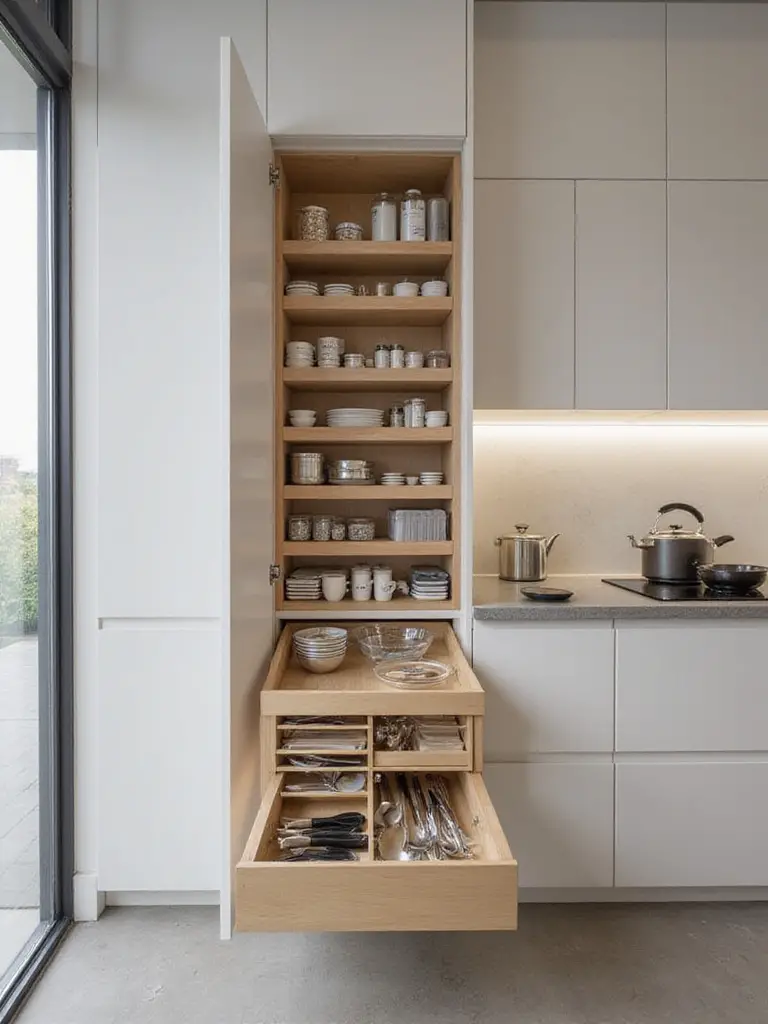
Today’s innovative storage features transform how kitchens function:
- Deep drawers with customizable dividers for pots, pans, and lids
- Vertical dividers for baking sheets and cutting boards
- Pull-out spice racks that make every jar visible and accessible
- Corner solutions like lazy Susans or pull-out shelving that eliminate wasted space
- Appliance garages that keep countertops clear while keeping frequently used items accessible
Do you see how huge that is? When everything has a designated place—and that place makes sense ergonomically—cooking becomes more efficient and enjoyable. The kitchen functions better while looking cleaner and more intentional. This is why I spend more time planning storage with clients than almost any other aspect of kitchen design.
15. Integrated Appliances: Achieve a Seamless and Streamlined Look in Your Modern Kitchen
Integrated appliances have revolutionized modern kitchen interiors by concealing utilitarian elements behind cohesive cabinetry panels. This approach creates visual continuity and a more architectural feel, allowing the kitchen’s design features—rather than its equipment—to take center stage. The result is a more sophisticated, less cluttered space where the eye flows smoothly across uninterrupted surfaces.

The most commonly integrated appliances include refrigerators, dishwashers, and microwaves, though the trend has expanded to include everything from coffee machines to wine coolers. For the most seamless look, consider push-to-open mechanisms that eliminate the need for handles entirely. This handle-less approach creates an ultra-modern aesthetic where appliances virtually disappear into the cabinetry.
The missing piece is often proper planning—integrated appliances require precise measurements and coordination between cabinet makers and appliance specialists. This collaboration ensures perfect alignment and function, transforming ordinary kitchens into extraordinary spaces where design and technology harmonize beautifully.
16. Smart Kitchen Technology: Embrace Automation and Convenience in Your Modern Kitchen
Smart technology has transformed modern kitchen interiors from merely functional spaces to intuitive environments that anticipate and respond to our needs. These innovations enhance convenience through automation, provide real-time information through connectivity, and allow remote management of kitchen functions. The result is a more efficient, personalized cooking experience that aligns perfectly with contemporary lifestyles.
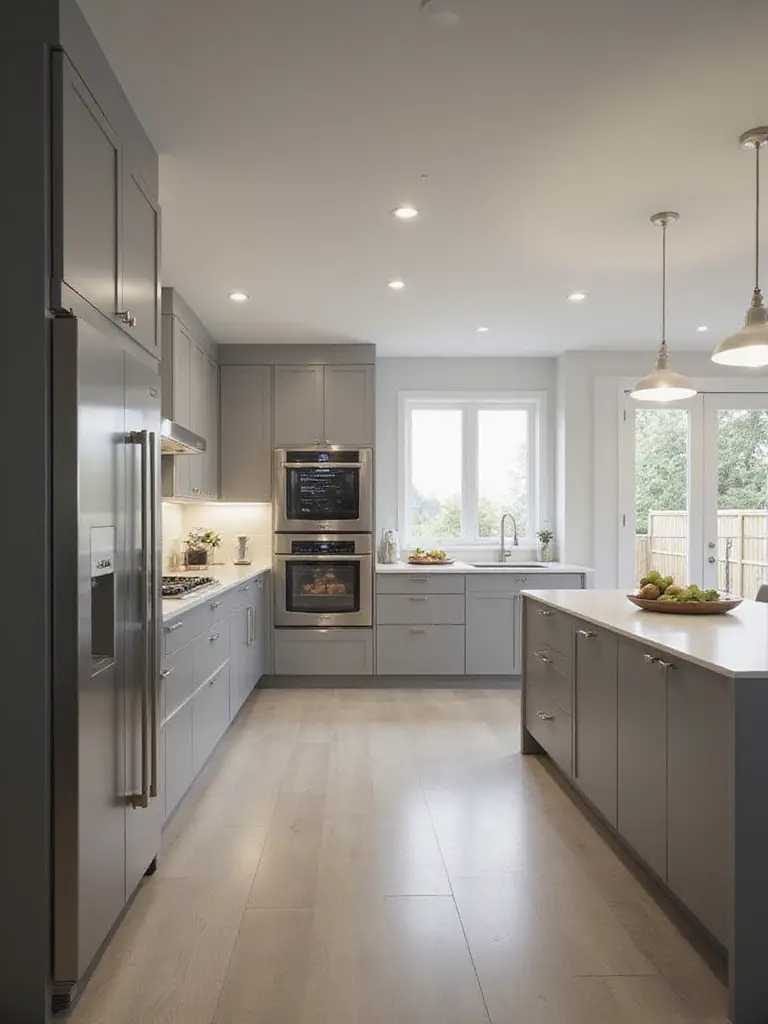
The landscape of smart kitchen technology continues to evolve with impressive options:
- Refrigerators that track inventory and suggest recipes based on available ingredients
- Ovens that can be preheated remotely and offer guided cooking programs
- Faucets that dispense precise water amounts with voice commands
- Lighting systems that adjust automatically based on time of day or activities
- Central hubs that control multiple appliances and provide access to recipes and tutorials
My experience went like this: I was initially skeptical about smart kitchen technology, considering it a luxury rather than a necessity. Then I installed a smart oven in my own kitchen and discovered how transformative it was to preheat while driving home from work, receive notifications when food was ready, and access guided cooking programs that expanded my culinary repertoire.
17. Go Green with Energy-Efficient Appliances: Sustainability Meets Modern Kitchen Style
Energy-efficient appliances represent a perfect alignment of values and aesthetics in modern kitchen interiors. They embody the minimalist principle that good design should reduce waste in all forms—energy, water, and resources. Beyond the environmental benefits, these appliances translate to tangible savings on utility bills, making them practical investments that pay dividends over time.
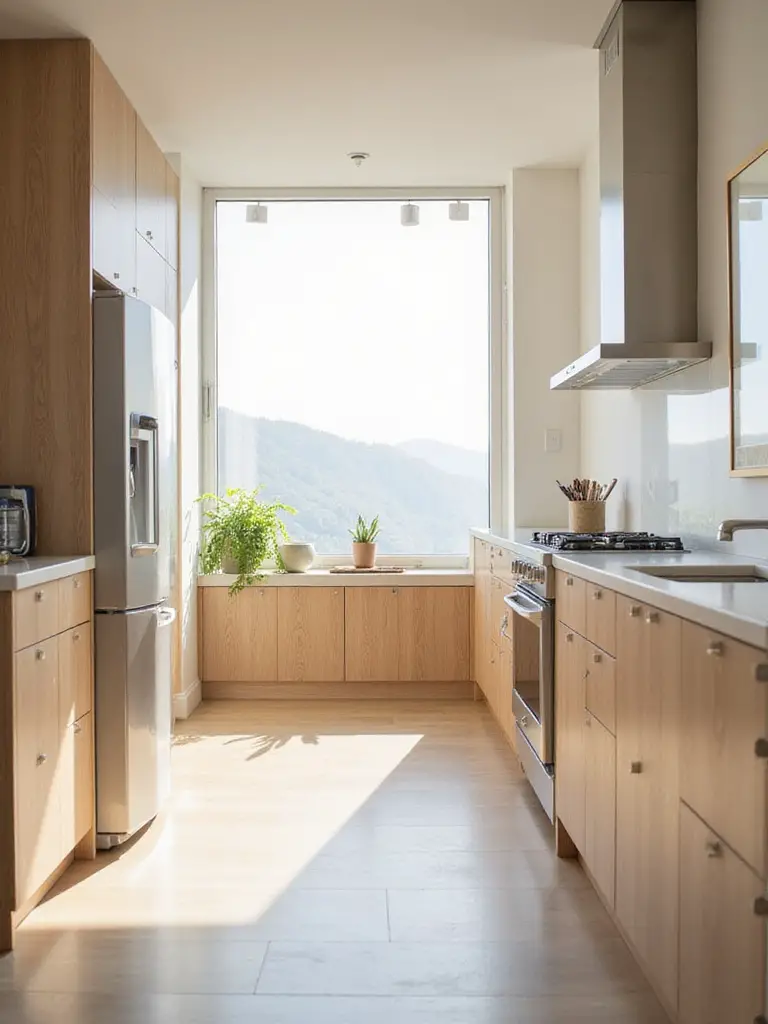
When selecting energy-efficient kitchen appliances, look for:
- Energy Star certification as the baseline requirement
- Smart sensors that automatically adjust settings based on usage
- Advanced insulation in refrigerators and ovens
- Induction cooktops that transfer heat directly to cookware
- Water-saving features in dishwashers
It works something like this: A standard refrigerator might cost $70 annually to operate, while an Energy Star model might cost $40—a seemingly small difference that compounds over the appliance’s lifespan. When multiplied across all kitchen appliances, these savings become substantial while reducing your home’s environmental footprint.
18. Statement Lighting Fixtures: Illuminating Your Modern Kitchen with Design Flair
Statement lighting elevates modern kitchen interiors from merely functional to truly memorable. Unlike purely utilitarian fixtures, statement lighting serves as jewelry for the space—adding personality, creating focal points, and defining the kitchen’s style. These distinctive pieces draw the eye upward, adding vertical interest in a room where horizontal planes typically dominate.
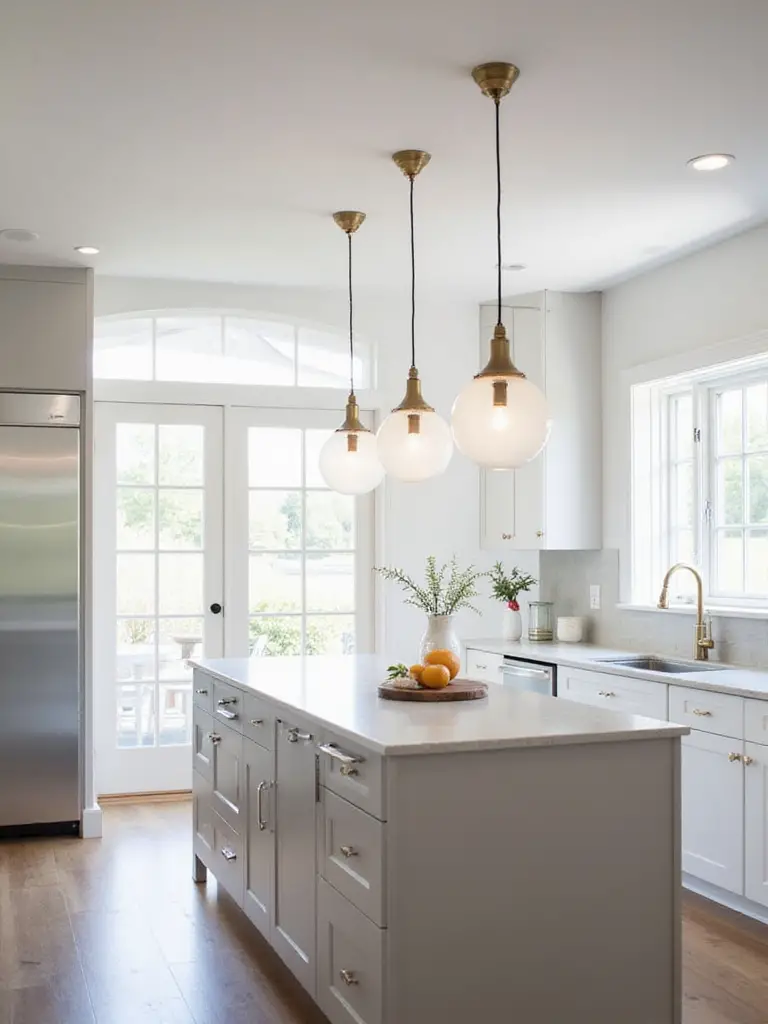
Popular statement lighting options for modern kitchens include:
- Sculptural pendant lights suspended individually or in clusters above islands
- Contemporary chandeliers that reinterpret traditional forms with clean lines
- Linear suspension lights that provide both task lighting and visual impact
- Oversized dome fixtures that make bold geometric statements
The crucial element is finding the right scale and proportion for your space. An undersized fixture will look lost, while an oversized one can overwhelm the room. Consider installing dimmers to control the mood and ambiance—allowing your statement piece to transition from practical task lighting during meal prep to subtle ambient lighting during dinner.
19. Under-Cabinet Lighting: Adding Practicality and Ambiance to Your Modern Kitchen
Under-cabinet lighting transforms modern kitchen interiors through its dual benefits of enhanced functionality and atmospheric appeal. Strategically positioned beneath upper cabinets, these lights eliminate shadows on countertops, making food preparation safer and more precise. This targeted illumination proves especially valuable when working with knives or reading recipes, preventing eye strain and improving overall kitchen efficiency.
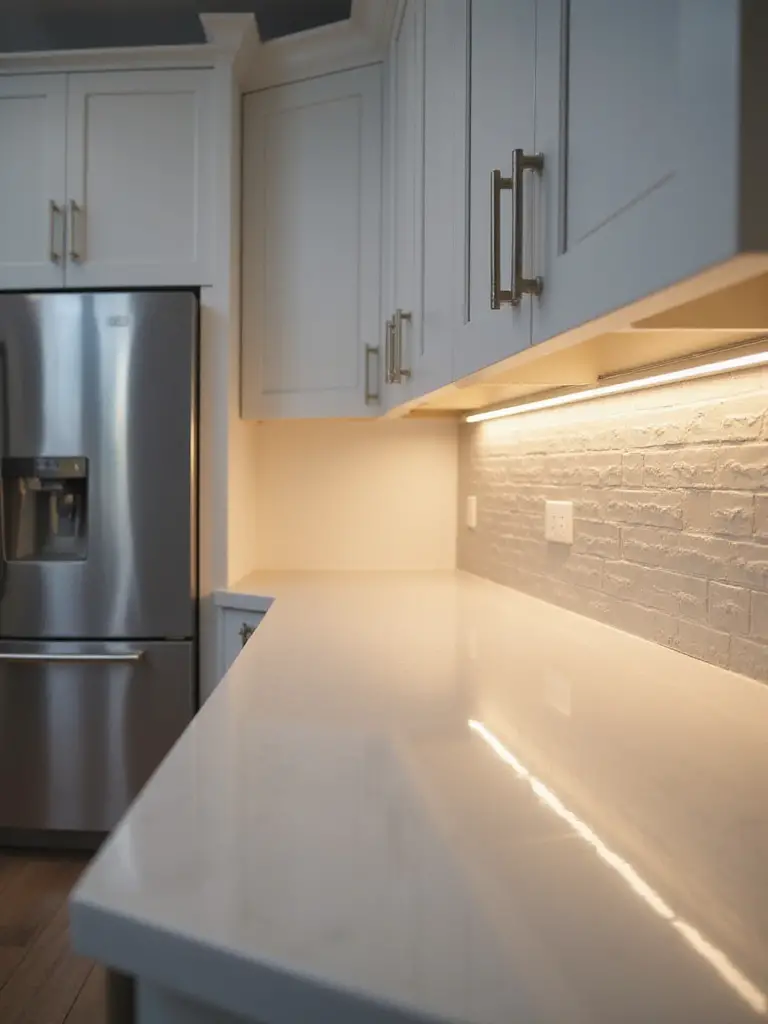
LED strip lights have become the preferred choice for modern kitchens due to their slim profile, energy efficiency, and even light distribution. They virtually disappear when mounted under cabinets while providing consistent illumination across the entire countertop. For added versatility, consider color-changing LED strips that allow you to transition from bright, cool white for task lighting to warmer tones for evening ambiance.
Here’s what happened when I added under-cabinet lighting to my own kitchen: not only did it improve functionality, but it also created a welcoming glow that made the space feel more inviting at night—an unexpected benefit that transformed how we use the kitchen during evening hours.
20. Elevate with Brass and Gold Hardware: Adding a Touch of Glamour to Your Modern Kitchen
Brass and gold hardware infuse modern kitchen interiors with warmth and subtle luxury. In spaces often dominated by cool tones and hard surfaces, these metallic finishes act as sophisticated jewelry that catches the light and adds dimension. They create beautiful contrast against matte cabinets, marble countertops, or concrete surfaces, preventing minimalist kitchens from feeling too austere or clinical.

The versatility of these warm metals extends across numerous kitchen elements:
- Cabinet pulls and knobs in sleek, contemporary profiles
- Statement faucets that become focal points at the sink
- Pendant lights with brass or gold accents
- Shelf brackets that add subtle gleam to open shelving
- Appliance handles for a truly cohesive look
Perhaps you’ve already guessed that the finish matters tremendously. Polished brass offers a more traditional, glamorous look, while brushed or satin finishes provide a more subdued, contemporary feel. Before committing, order samples of different hardware finishes and test them against your cabinet doors and countertops in various lighting conditions.
21. Touchless Faucets: Embrace Hygiene and Modern Convenience in Your Kitchen
Touchless faucets have become essential features in modern kitchen interiors, perfectly aligning with contemporary values of cleanliness and efficiency. The primary advantage is enhanced hygiene—eliminating the need to touch handles with messy or contaminated hands significantly reduces cross-contamination risks during food preparation. This hands-free operation also offers remarkable convenience when your hands are full or covered in ingredients.
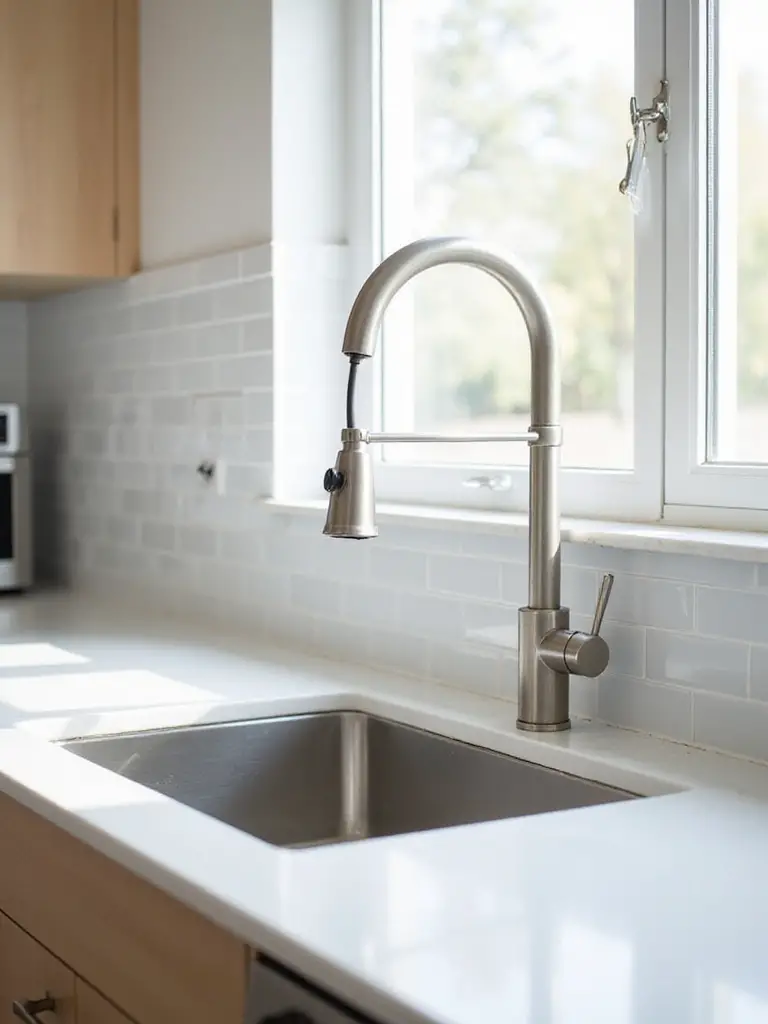
The technology behind these innovative fixtures has evolved significantly:
- Infrared sensors detect hand movement to trigger water flow
- Capacitive sensing responds to proximity rather than direct contact
- Voice-activated models integrate with smart home systems
- Temperature pre-sets allow for customized water temperature without adjustment
The potential here is enormous, especially when integrated with smart home systems that allow for water usage monitoring and conservation. Some advanced models can even dispense precise amounts of water through voice commands—perfect for recipe requirements or filling containers without overflow.
22. Bring the Outdoors In with Indoor Herb Gardens: Freshness and Greenery for Your Modern Kitchen
Indoor herb gardens introduce vital natural elements to modern kitchen interiors, softening the clean lines and hard surfaces that define contemporary spaces. Beyond their aesthetic appeal, these living accents provide immediate access to fresh flavors for cooking, elevating everyday meals with garden-to-table ingredients. The aromatic qualities of herbs also add a multisensory dimension to the kitchen experience.
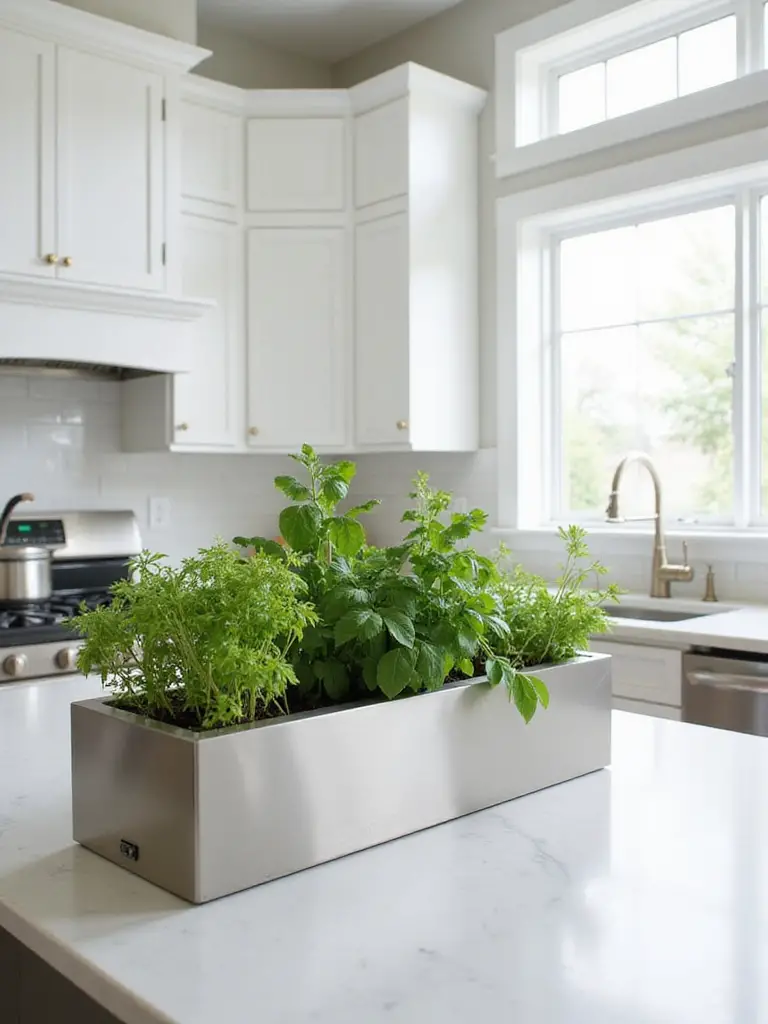
Creating a successful indoor herb garden requires consideration of several key factors:
- Light requirements (most culinary herbs need at least 6 hours of direct sunlight)
- Space allocation (countertops, windowsills, or vertical wall gardens)
- Proper drainage and watering systems
- Herb selection based on cooking preferences and growing conditions
Let me show you another perspective: beyond traditional potted herbs, consider a hydroponic system for soil-free growing. These contemporary systems align beautifully with modern kitchen aesthetics while providing optimal growing conditions through built-in lighting and nutrient delivery. They’re particularly effective in kitchens with limited natural light.
Conclusion: Crafting Your Dream Modern Kitchen Interior
Creating a stunning modern kitchen interior is about thoughtfully balancing form, function, and personal expression. Each of these 22 elements contributes to a space that not only looks remarkable but also enhances your daily experience. From the enduring elegance of quartz countertops and handleless cabinets to the warmth of wood accents and the convenience of smart technology, modern kitchens can be both sophisticated and welcoming.
Remember that the most successful modern kitchen interiors reflect how you actually live and cook. Prioritize the elements that align with your lifestyle while maintaining clean lines and thoughtful organization. With careful planning and attention to quality materials, your kitchen will become not just the heart of your home, but a space that truly elevates everyday living through beautiful, purposeful design.

